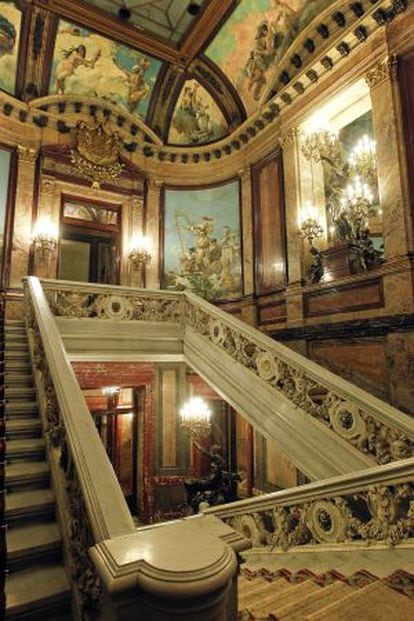The cost of maintaining a good name
Set up to promote Spain abroad, the Foreign Ministry’s ‘casas’ are facing heavy cuts


Faced with ever-deeper cuts to its budget, the Foreign Ministry is inviting the private sector to help fund its six casas, institutions tasked with strengthening cultural relations between Spain and Africa, Asia, the Arab world, the Mediterranean, and Israel and the global Jewish community. In March, the government appointed a new set of directors for the institutions, paying them 30 percent less than their predecessors.
In keeping with the new regime, Tomás Poveda, a former board member of General Electric and now the director of the Casa de América in Madrid, has to make his own way to work at the Linares Palace on the capital’s emblematic Plaza de Cibeles. His predecessor would have been chauffeured to work in one of the fleet of government cars the Casa de América had at its disposal and would have been paid upwards of 120,000 euros a year. He would also have enjoyed business-class travel, while Poveda flies coach. Gone, too, will be the no-questions-asked expenses that included lengthy lunches in top restaurants, and the latest communications gadgetry, all listed in the outgoing directors’ accounts.
The casas were set up in the 1990s, potent symbols of Spain’s then-booming economy, and an expression of the country’s growing self-confidence in its international role. They were given annual budgets of up to 10 million euros. Even when the economy slumped in 2008, they continued to overspend, their accounts running ever deeper into the red as their budgets were successfully cut: in the last year alone, their funding has been slashed by a third; and they will likely see further belt-tightening measures. In the case of the Casa Árabe in Madrid, half of its five-million-euro annual budget went on salaries. Now, it cannot afford to buy photocopy paper, or pay for a decent English translation of its website. And some of the ornately decorated salons in the splendid 19th-century neo-Mudéjar red-brick former school in which it is housed, close to the Retiro park in Madrid, are now available to hire. To celebrate its 20th anniversary this year, the Casa de América has decided to recycle a logo it used a decade ago to mark 10 years in existence.
Aside from the need to reduce spending, the long and the short of the story is that the Foreign Ministry’s regional casas have been disastrously managed since their inception — something the financial crisis has brought to light. For example, this year’s budget for the six institutions had already been spent by March this year. The Casa de América had used up its entire annual wage bill by April. The new team at the Foreign Ministry largely blames the previous Socialist Party administration for failing to get a grip on spending, and talks in terms of “waste and poor management.”
The challenge the Foreign Ministry now faces is how to maintain the links established by the casas around the world — and uphold brand Spain — at a time when, quite simply, there is no public money available.
María Claver, the head of the Foreign Ministry’s Media Relations department, talks in terms of “combining forces,” and “creating synergies” to build on the global brand Spain has established over the years through such things as its World Cup-winning national soccer team; its internationally renowned chefs, olive oil, ham and wines; Oscar winner Pedro Almodóvar; its art galleries; and not forgetting its beaches, bullfighting and, of course, flamenco.
In response, the government earlier this year created the post of high commissioner for the Spain brand as part of its economic diplomacy drive. The job has gone to Carlos Espinosa de los Monteros — deputy chairman of Inditex, owner of the Zara brand and one of Spain’s most successful multinationals — and carries the rank of secretary of state.
The Foreign Ministry says Spain’s image and reputation have been eroded over the past few years, be it in the form of the rise in the cost of government borrowing or the lack of confidence expressed in international circles and media at the country’s failure to get to grips with its problems, particularly with the troubled savings banks.
Speaking on October 8 at a seminar on international branding in the Casa de America, Espinosa de los Monteros said his mission was “to recover Spain’s image and return it to a position of prominence.” The high commissioner’s main objective will be to improve Spain’s image abroad, as well as support the planning of activities by the various bodies of the Public Administration Services at an international level and oversee their completion. He will also support overseas promotion activities and foster joint public-private partnership action in this area.
Despite the fall from grace, the perception of Spain is out of sync with the country’s reality and potential, despite all its problems. For example, there are around 20 Spanish multinationals holding leading positions in the global economy and last year 60 percent of the revenues of the companies that comprise the Ibex-35, the blue chip index of the Madrid stock exchange, were generated abroad.
“This is a long-term project that has to involve the entire country, everybody must feel part of it. It has to involve the public as well as the private sector, and it has to bring the regions into the equation,” Espinosa de los Monteros told delegates. “It is inconceivable that a country is not constantly concerned about its image internationally. Positive perceptions of our country abroad benefit everybody. A country cannot afford to lag behind in this regard. We have to have a policy and apply it actively. The problem at the moment is that Spain lacks a policy and the instruments to apply it.”
Espinosa de los Monteros is working closely with the ICEX foreign trade institute, the Instituto Cervantes language and arts body, and the Círculo de Empresarios, which represents the country’s business community, as well as the casas, on specific goals. One recent outcome of this new approach was the visit last month to India of a high-level trade delegation led by King Juan Carlos that sealed five economic and trade agreements.
Branding Spain means creating and sustaining a consistent image of Spain, says Espinosa de los Monteros. This involves synergy between the institutions and the people who run real brands that set standards throughout the world. Nowadays, Spanish companies are characterized by a desire for growth and globalization.
A brand is not all things to all people. A brand is more than just a logo. It can symbolize a country. Consistently paying attention to all points of contact between the brand and the public is critical for transmitting a strong and complete image of the country. Experts agree that there are many versions of the brand known as “Spain,” not one unique brand that applies throughout the world. The components of that image include things like its cultural riches, the personality of its people, the innovation of its companies, and its natural resources.
Spain already has several corporate brands that act as ambassadors for the overall Spanish brand: among them are Telefónica in telecommunications, Freixenet in sparkling wines, Santander in banking, and Real Madrid in sports. These brands set standards and, as leaders, they provide incentives for the development of their sector.
Similarly, in the summer of 2011, the top Spanish luxury brands — led by Loewe, Numanthia, Lladró, Carrera y Carrera, Natura Bissé, Pagos Marqués de Griñón, Village Olive, La Amarilla de Ronda and Sotogrande — set up an organization to promote themselves abroad. Called Círculo Español del Lujo Fortuny (or, the Spanish Circle of Fortuny Luxury), this corporate union joined European organization the European Cultural and Creative Industries Alliance and has also forged links with British, French and Italian bodies.
The government has given its support to Spanish luxury brands, as it thinks they will continue to rise in 2012. This will be focused on helping to promote these brands abroad, for both consumer exports and tourism imports. Both the government and the Círculo Fortuny believe this is a rare opportunity for Spanish companies to increase their sales, thus creating more jobs, which should then be reinvested in the economy.
As for the future of the casas, this will now depend on ever-greater efficiencies. This will mean sharing resources, greater coordination with embassies, no outsourcing, cost-cutting that will see a reduction in overseas visits and hospitality, and, inevitably, further staff reductions. Espinosa de los Monteros also wants to encourage volunteers to play a role, and intends to use the social networks to attract people to give their time free of charge “to build brand Spain.”
The activities of the casas themselves will undergo a reorientation toward more commercial goals. The Valencia-based Casa Sefarad is working on a range of kosher food and drink products that it hopes to sell around the world. Last week the Casa Árabe held a week-long series of events dedicated to Algeria that included an economic forum attended by Algerian SMEs and representatives from the country’s Industry Ministry. Another is planned that will focus on Tunisia. Casa de América is working on similar initiatives in relation to the United States and Latin America. In conjunction with the IE Business School, it has set up a monthly event to help Spanish companies gain a foothold in the American markets, the first of which takes place on November 6, and looks at Colombia. Next year Casa Asia will set up a 12-month project to open up the Japanese market to Spanish companies.










































